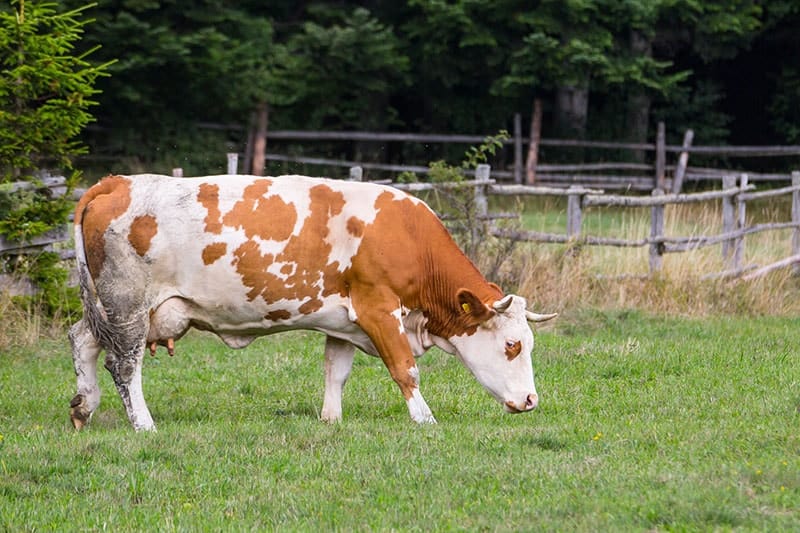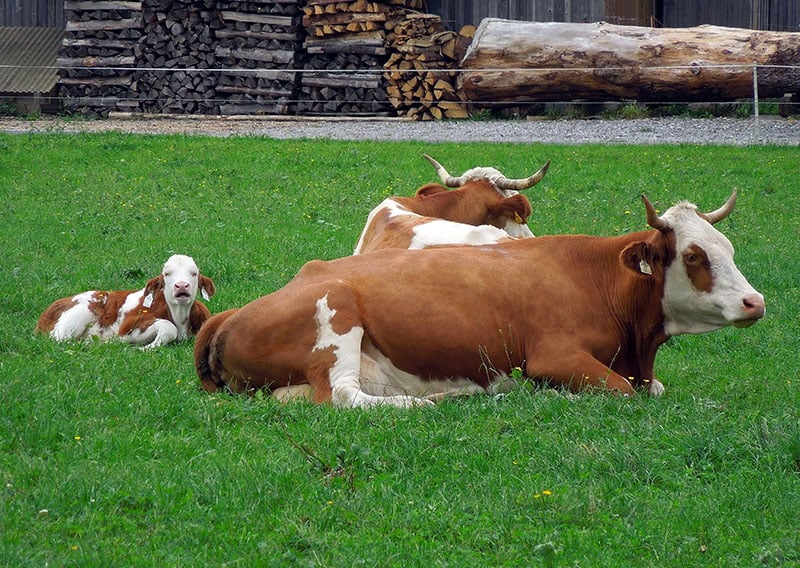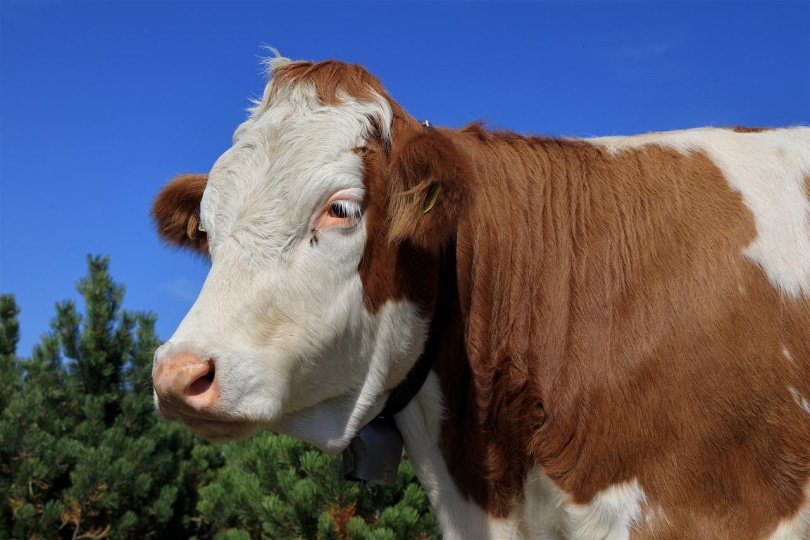Fleckvieh cattle were developed in the 1830s to be a dual-purpose breed. They can be bred with either dairy or beef cattle to increase the production of both. The Fleckvieh breed was developed from Simmental cattle. In some parts of the world today, “Fleckvieh” and “Simmental” are used interchangeably, or the cattle are called “Fleckvieh Simmental.”
Fleckvieh cattle can be kept in all areas of production around the world and can adapt to nearly all environments. They are popular to keep because they produce high-quality meat and milk, have long lifespans, and experience overall good health.

Quick Facts About Fleckvieh Cattle
| Breed Name: | Fleckvieh |
| Place of Origin: | Austria and Germany |
| Uses: | Milk and meat production |
| Bull Size: | 2,425 – 2,866 pounds |
| Cow Size: | 1,543 – 1,763 pounds |
| Color: | Solid red or red & white (pied) |
| Lifespan: | Over 6 years |
| Climate Tolerance: | All climates |
| Care Level: | Easy |
| Milk Production: | 73 – 82 pounds per day during lactations |
| Global Population: | 41 million |
Fleckvieh Cattle Origins
In the 1830s, Simmental cattle in Switzerland were imported to Germany and Austria. Simmental cattle were known for their size and quality of milk production, and the goal was to use them to improve dual-purpose cattle breeds in these other countries by breeding them with local stock. The Fleckvieh cattle became an independent breed in 1920. The cattle were used not only for milk and meat but also as draft oxen.
Fleckvieh is German for “spotted cattle.” In 1968, the breed was imported to the United States to increase the size of the existing cattle. Today, the breed is seen in many countries around the world.


Fleckvieh Characteristics
Fleckvieh cattle have been bred selectively to produce high yields of both meat and milk. In comparison to other breeds, the cows have an easier time calving, and the calves have higher survival rates.
The cattle are docile and easy to manage. Their good natures keep them relatively stress free. The cows are highly maternal and produce plenty of milk for their calves. They are known for their udder health and milking speed.
The milk produced by the cows typically contains 4.2% butterfat and 3.7 protein, making it a quality product that can increase profits.
Fleckvieh cattle can graze in almost any environment. They are adaptable and hardy. They are suitable choices for barns and pastures. Their strong legs enable them to walk long distances if they have to. This helps them be successful in different climatic conditions all over the world. They can adapt to all farming systems.
Their health keeps overall vet costs low. The bulls have high growth rates and produce lean meat at younger ages than some other breeds.
The Fleckvieh cattle have so many desirable characteristics that they are often used in crossbreeding. Established dairy and beef cattle are crossbred with Fleckvieh cattle to increase the production, health, and utilization of the animals.
Uses
Fleckvieh cattle are used today for milk and meat production. They are also used for crossbreeding to increase the size and production of existing cattle populations. They are popular with breeders because the bulls grow quickly and produce lean meat.
The females produce high-quality milk, and the calves can be sold for additional income. The skins can be used to make high-quality leather items. The longevity of the cattle and the high profits that they yield make them desired choices among farmers.

Appearance
Both the Fleckvieh bulls and cows have the same coloring, which is red pied with white markings on the belly and legs. The faces are white. Some Fleckvieh cattle can be solid red with no white markings.
The cows stand approximately 4.5 feet tall. The bulls are approximately 5.5 feet tall. They have well-formed, muscular bodies. The bulls have a more rounded shape with a hump between the head and shoulder blades. Cows have straight backs and a squarer shape.
Population/Distribution
The Fleckvieh cattle breed is the second largest population of cattle in the world with 41 million individuals. The breed is seen in many countries today. In addition to North America and Switzerland, Fleckvieh cattle can be found in Belgium, Peru, South America, South Africa, Uruguay, and the Netherlands.

Are Fleckvieh Cattle Good for Small-Scale Farming?
Fleckvieh cattle are good for small-scale farming and desired by farmers. The milk production is high with Fleckvieh cows as long as they are receiving quality feed and care. They can also produce more milk with less feed than other breeds.
Fleckvieh cattle are also resistant to common diseases, such as east coast fever and mastitis. Their longevity, ease of care, and high production yield make them ideal choices for small-scale farming if there is adequate space for them.
Fleckvieh cattle were developed in the 1830s as a dual-purpose breed. Today, they are the second most populous breed in the world and produce high-quality milk and meat. Their ease of care, docile nature, and limited health issues make them ideal choices for farmers. These cattle are found in many countries around the world, with a population of 41 million.
Related Read:
- Beefalo Cattle Breed: Facts, Pictures, Uses, Origins & Characteristics
- Simmental Cattle Breed: Facts, Uses, Origins & Characteristics (with Pictures)
Featured Image Credit: WFranz, Pixabay
